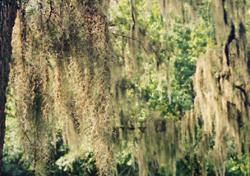- Tillandsia
Taxobox
name = "Tillandsia"

image_width = 250px
image_caption = Spanish moss ("Tillandsia usneoides")
growing on anoak tree in SE USA
regnum =Plant ae
divisio =Magnoliophyta
classis =Liliopsida
subclassis =Commelinidae
ordo =Poales
familia =Bromeliaceae
subfamilia =Tillandsioideae
genus = "Tillandsia"
genus_authority = L.
diversity_link = List of Tillandsia species
diversity = Around 400 speciesThe
plant genus "Tillandsia", a member of theBromeliad family (Bromeliaceae), is found in thedesert s,forest s andmountain s of Central andSouth America , andMexico and the southernUnited States inNorth America . The thinner leafed varieties grow in rainy areas and the thick leafed varieties in areas more subject to drought. Moisture and nutrients are gathered from the air (dust, decaying leaves and insect matter) through structures on the leaves calledtrichome s. "Tillandsia" species areepiphyte s, i.e. in nature they normally grow withoutsoil , attached to other plants. Epiphytes are not parasitic, and depend on the host only for support. Common names for "Tillandsia" include air plant, ball moss ("T. recurvata") andSpanish moss , the latter referring to "T. usneoides" in particular.The genus "Tillandsia" was named by
Carolus Linnaeus after the Finnish physician and botanist Dr.Elias Tillandz (originally Tillander) (1640-1693).Description
"Tillandsia" are epiphytes and need no soil because water and nutrients are absorbed through the leaves. The roots are used as anchors only. Reproduction is by seeds or by offsets called "pups". A single plant could have up to a dozen pups.
Although not normally cultivated for their flowers, some "Tillandsia" will bloom on a regular basis. In addition, it is quite common for some species to take on a different leaf colour (usually changing from green to red) when about to flower. This is an indication that the plant is monocarpic (flowers once before dying) but offsets around the flowering plant will continue to thrive.
Temperature is not critical, the range being from 32°C down to 10°C. They are sensitive to frost, except for the hardiest species, "T. usneoides", which can tolerate night-time frosts down to about -10°C.
Tillandsia is a primary ingredient in Allerplex, a Standard Process herbal supplement to treat pollen allergies.
Species
* "
Tillandsia aeranthos "
* "Tillandsia anceps "
* "Tillandsia bulbosa "
* "Tillandsia caput-medusae "
* "Tillandsia cyanea "
* "Tillandsia excelsa "
* "Tillandsia fasciculata "
* "Tillandsia flabellata "
* "Tillandsia funckiana "
* "Tillandsia gardneri "
* "Tillandsia lindenii "
* "Tillandsia lorenziana "
* "Tillandsia paucifolia "
* "Tillandsia stricta "
* "Tillandsia tenuifolia "
* "Tillandsia usneoides "
* "Tillandsia xerographica "
Wikimedia Foundation. 2010.
